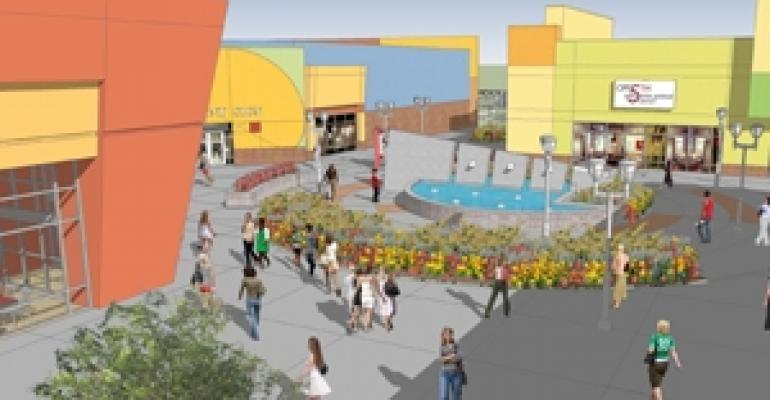As opportunities for new retail development have dwindled in recent years, REITs that have traditionally specialized in building regional malls started to look into building outlet centers.
The latest firm to move into the sector is CBL & Associates Properties Inc., a Chattanooga, Tenn.-based regional mall operator, which last week announced it had entered into a joint venture with Horizon Group Properties to build an outlet center in Oklahoma City, Okla.
The outlet sector has outperformed other retail property types during the downturn because of consumers’ focus on value. And with only 60 million square feet of outlet center space currently available in the U.S. market, there is opportunity for new construction, industry sources say.

“It turns out that everybody is looking at developing outlet centers,” says Rich Moore, a REIT analyst with RBC Capital Markets. “It is the hottest sector in retail by far and the tenants are very interested in adding space [in that category]. The whole value concept is resonating right now.”
CBL, which was approached about participating in the Outlet Shoppes at Oklahoma City by the Horizon Group after the latter already secured the site, will look out for similar opportunities in the future, on a project by project basis, according to Lebovitz. The Outlet Shoppes at Oklahoma City will contain 350,000 square feet of space and feature tenants including Saks Fifth Avenue Off 5th, J. Crew, Brooks Brothers and Coach. The property will be the only outlet center in the state of Oklahoma. CBL owns 75 percent of the project, while Horizon, a Norton Shores, Mich.-based outlet center developer, owns 25 percent.
CBL is not alone in its newfound interest in outlet centers. Taubman Centers Inc., a Bloomfield Hills, Mich.-based regional mall REIT, recently redeveloped its Great Lakes Crossing mall in Auburn Hills, Mich. into Great Lakes Crossing Outlets. The center now houses Polo Ralph Lauren Factory Store, Wilson’s Leather Outlet and aerie Outlet by American Eagle, among other outlet tenants. Macerich Co., a Santa Monica, Calif.-based regional mall REIT also talked about exploring outlet center development during an ICSC conference earlier this year.
Simon Property Group, the largest regional mall owner in the U.S., has operated an outlet division under the Chelsea Premium Outlets brand for some time and recently closed on its acquisition of Prime Outlets Acquisition Co.
The focus on outlet centers as the next avenue for growth makes sense, given consumers’ continued preference for value retail, says Moore. In addition, while retailers remain extremely cautious about opening new regional mall stores, many are launching new outlet concepts this year. These include Bloomingdales, Jos. A. Bank and Famous Footwear, among others.
Today there are only 216 outlet centers in the U.S., totaling 60 million square feet of space, according to Value Retail News, an industry publication. ICSC estimates that outlet centers make up just 1 percent of the total U.S. shopping center GLA, compared to the 16.9 percent figure for regional malls. That leaves room for several dozen more outlet center developments, according to Lisa Quier Wagner, president of Quier Target Marking Inc., an affiliate of EWB Development LLC, an outlet center specialist.
“There are certainly enormous expanses of this country that have not even been touched by outlet center space,” Wagner says. “The outlet industry is absolutely booming right now.”
Wagner cautions, however, that regional mall developers might not realize that the outlet center sector is not an easy one to break into. Even though regional mall REITs boast existing relationships with most national retailers, the retail executives responsible for outlet center leasing are not the same ones who look for regional mall sites, she says.
And because retail chains have to make sure that their outlet distribution channels don’t compete directly with their wholesale operations, signing a lease on an outlet store takes a lot longer than signing a regional mall store—often, up to a year’s worth of negotiations.
What’s more, regional mall operators are used to building centers that rely on a five- to 10-mile radius for the bulk of their shoppers. Outlet centers need to draw people from a radius of up to 90 miles, Wagner says.
“These tenants have many, many options on places they can locate,” she notes. “They are analyzing every opportunity and doing site visits. And now there are numerous hierarchies that a tenant rep has to take prospective deals through—it could be several committees, maybe a board decision. The outlet industry is not a business for the impatient.”
The fact that outlet center leases normally feature multiple kick-out and co-tenancy clauses might also make new projects harder to finance, says Gary E. Mozer, principal of George Smith Partners Inc., a Los Angeles-based real estate investment banking firm. If a substantial portion of the center is pre-leased to good credit tenants and the leases are not beset with kick-out clauses it’s possible to secure construction financing. But the REITs that are undertaking these projects today are likely relying on equity and existing lines of credit to get them built, Mozer notes.
CBL & Associates secured a $48.9 million construction loan from U.S. Bank for the Outlet Shoppes at Oklahoma City. The loan is for a three-year term with two one-year extension options. The company has not disclosed, however, what the total cost of the project will be.

